The nuclear magnetic resonance (NMR) fat analyzers market is estimated at USD 148.7 million in 2025 and is expected to reach USD 361.7 million by 2035, representing substantial growth. The accelerating adoption of advanced analytical instruments and precision testing solutions across the dairy, meat processing, oilseed analysis, and processed food sectors drives this growth.
The first half of the decade (2025-2030) will see the market increase from USD 148.7 million to approximately USD 231.9 million, adding USD 83.2 million in value, which constitutes 39% of the total forecasted growth period. This phase will be characterized by the rapid adoption of rapid analyzer systems, driven by increasing food quality standards and laboratory automation programs worldwide. Advanced analytical capabilities and real-time testing features will become standard expectations rather than premium options.
The latter half (2030-2035) is expected to witness accelerated growth, increasing from USD 231.9 million to USD 361.7 million, representing an addition of USD 129.8 million, or 61% of the decade's expansion. This period will be defined by mass market penetration of intelligent analytical systems, integration with comprehensive quality management platforms, and seamless compatibility with existing laboratory infrastructure.
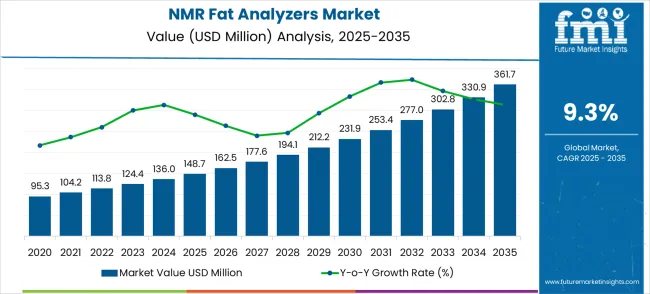
The NMR Fat Analyzers market demonstrates distinct growth phases with varying market characteristics and competitive dynamics. Between 2025 and 2030, the market progresses through its technology adoption phase, expanding from USD 148.7 million to USD 231.9 million with steady annual increments averaging 9.2% growth. This period marks the transition from basic analytical units to intelligent systems, characterized by enhanced precision capabilities and automated testing systems becoming mainstream features.
The 2025-2030 phase adds USD 83.2 million to market value, representing 39% of total decade expansion. Market maturation factors include the standardization of testing protocols, declining component costs for NMR technology, and increasing food industry awareness of the benefits of rapid fat analysis, which can reach 95-98% accuracy in nutritional testing applications. The competitive landscape during this period features established analytical instrument companies, such as Bruker and Oxford Instruments, expanding their NMR analyzer portfolios, while new entrants focus on rapid testing systems and enhanced precision capabilities.
From 2030 to 2035, market dynamics shift toward advanced integration and multi-laboratory deployment, with growth accelerating from USD 231.9 million to USD 361.7 million, representing an addition of USD 129.8 million, or 61% of the total expansion. This phase transition logic centers on intelligent analytical systems, integration with laboratory information management systems, and deployment across diverse testing scenarios, becoming standard rather than specialized applications. The competitive environment matures, with a focus shifting from basic fat analysis capabilities to comprehensive nutritional testing systems and integration with quality management and regulatory compliance platforms.
| Metric | Value |
|---|---|
| $ Market Value (2025) → | USD 148.7 million |
| $ Market Forecast (2035) ↑ | USD 361.7 million |
| # Growth Rate ★ | 9.3% CAGR |
| Leading Technology → | Rapid Analyzers (Within 1 Minute) Type |
| Primary Application → | Dairy Products Segment |
The market demonstrates strong fundamentals, with rapid analyzer types capturing a dominant share due to their advanced speed and precision analytical capabilities. Dairy Products applications drive primary demand, supported by increasing food quality control spending and the modernization of nutritional analysis. Geographic expansion remains concentrated in developed markets with established food processing infrastructure, while emerging economies exhibit accelerating adoption rates, driven by food safety modernization and rising investments in quality control.
Market expansion rests on three fundamental shifts driving adoption across food processing and laboratory sectors. 1. Food quality control demand creates compelling operational advantages through NMR fat analyzers that provide rapid nutritional analysis and quality assessment without sample destruction, enabling facilities to optimize product quality while maintaining regulatory compliance and reducing testing costs. 2. Food processing modernization programs accelerate as manufacturers worldwide seek advanced analytical equipment that complements existing quality control systems, enabling precise fat content measurement and nutritional profiling applications that align with food safety standards and consumer transparency requirements. 3. Regulatory compliance enhancement drives adoption from food processors and testing laboratories requiring reliable analytical solutions that minimize testing errors while maintaining operational efficiency during quality control and nutritional labeling processes.
However, growth faces headwinds from technology complexity challenges that vary across different laboratory environments regarding instrument operation and maintenance protocols, potentially limiting deployment flexibility in certain food processing facilities. Technical limitations also persist regarding sample preparation requirements and environmental conditions that may affect measurement precision in high-throughput testing environments or facilities with variable temperature and humidity conditions.
Primary Classification: The market segments by product type into Rapid Analyzers (Within 1 Minute) and Other Analyzers (2-5 Minutes) categories, representing the evolution from standard testing systems to high-speed analytical solutions for comprehensive nutritional analysis applications.
Secondary Breakdown: Application segmentation divides the market into Dairy Products, Meat, Oilseeds, Processed Foods, and Other sectors, reflecting distinct requirements for food processing operations, quality control laboratories, and nutritional analysis applications requiring accurate fat content measurement.
Regional Classification: Geographic distribution covers Asia Pacific, Europe, North America, Latin America, and the Middle East & Africa, with developed markets leading adoption while emerging economies show accelerating growth patterns driven by food safety modernization programs.
The segmentation structure reveals technology progression from standard multi-minute testing systems toward rapid one-minute analytical platforms with enhanced speed and precision capabilities, while application diversity spans from dairy processing operations to specialized meat analysis and oilseed testing applications requiring reliable fat content measurement solutions.
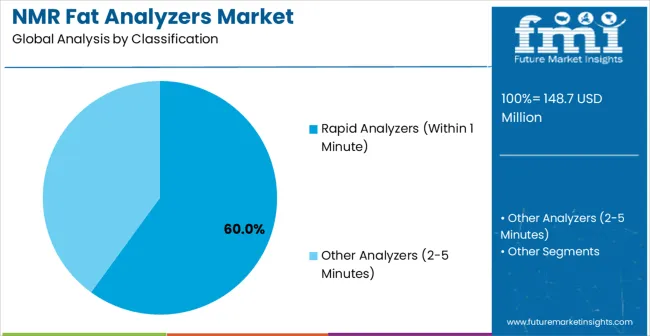
Market Position: Rapid Analyzers (Within 1 Minute) command the leading position in the NMR Fat Analyzers market with approximately 60-65% market share through advanced speed features, including high-throughput analysis, real-time results, and automated sample handling that enable rapid testing across diverse food processing environments.
Value Drivers: The segment benefits from food industry preference for rapid testing systems that provide immediate analytical results without requiring extended processing time or complex sample preparation. Advanced speed features enable deployment in production facilities, quality control laboratories, and processing operations where testing efficiency and throughput represent critical operational requirements.
Competitive Advantages: Rapid analyzer systems differentiate themselves through high-speed capability, precision measurement features, and integration with quality management systems, which enhance testing efficiency while maintaining consistent performance profiles suitable for continuous operation in food processing facilities.
Key market characteristics:
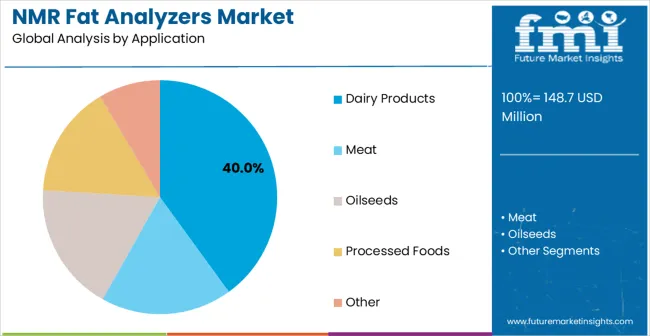
Market Context: Dairy Products applications dominate the NMR Fat Analyzers market with approximately 40-45% market share due to widespread adoption in dairy processing facilities, milk production operations, and cheese manufacturing plants that require accurate fat content analysis, nutritional profiling, and quality control applications that optimize product quality while maintaining regulatory compliance standards.
Appeal Factors: Dairy processing customers prioritize measurement accuracy, testing speed, and integration with existing quality control infrastructure that enables coordinated testing across multiple production processes. The segment benefits from substantial investments in food safety and modernization programs that emphasize the acquisition of advanced analytical equipment for nutritional labeling and quality assurance operations.
Growth Drivers: Dairy industry modernization programs incorporate NMR fat analyzers as standard equipment for nutritional analysis and quality control applications. At the same time, food safety regulations are increasing demand for accurate fat content measurement capabilities that integrate with regulatory compliance systems and minimize product quality risks.
Market Challenges: Regulatory specification requirements and dairy industry standards may limit operational flexibility in certain processing environments or specialized applications that require unique testing accuracy or high sample throughput.
Application dynamics include:
Growth Accelerators: Food quality control drives primary adoption as NMR fat analyzers provide rapid nutritional analysis capabilities that enable accurate fat content measurement without sample destruction, supporting food processing operations and quality assurance processes that require consistent testing accuracy and regulatory compliance. Laboratory automation demand accelerates market expansion as testing facilities seek reliable analytical solutions that minimize testing errors while maintaining operational efficiency during nutritional analysis and quality control processes. Food safety spending increases worldwide create sustained demand for advanced analytical systems that complement regulatory compliance requirements and provide operational flexibility in complex food processing environments.
Growth Inhibitors: Technology complexity challenges persist regarding instrument operation and maintenance protocols that may limit deployment effectiveness in diverse laboratory environments, smaller food processing facilities, or specialized testing applications that require custom analytical configurations and specialized operator training. Market fragmentation across multiple food industry specifications and testing standards creates compatibility concerns between different analytical systems and existing laboratory infrastructure, potentially limiting integration flexibility and standardization efforts.
Market Evolution Patterns: Adoption accelerates in food processing and laboratory sectors where analytical accuracy justifies system costs, with geographic concentration in developed markets transitioning toward mainstream adoption in emerging economies driven by food safety modernization and quality control infrastructure development. Technology development focuses on enhanced measurement speed, improved accuracy capabilities, and integration with laboratory information management systems that optimize testing workflow and regulatory compliance effectiveness. The market could face disruption if alternative analytical technologies or testing methodologies significantly alter food quality control processes or nutritional analysis requirements in food processing applications.
The NMR fat analyzers market is positioned for significant growth and technological evolution. As food manufacturers, quality control laboratories, and regulatory bodies across both developed and emerging markets seek analytical instruments that offer rapid testing, precise measurement, regulatory compliance, and automated operation capabilities, NMR fat analyzers are gaining prominence not just as basic analytical tools but as strategic quality control components in dairy processing, meat analysis, oilseed testing, nutritional labeling, and comprehensive food safety programs.
Rising food safety investments and laboratory automation programs in Asia-Pacific, Europe, and North America amplify demand, while manufacturers are capitalizing on innovations in NMR technology, artificial intelligence integration, and real-time analytical systems. Pathways like rapid testing, precision analytics, and sustainability-focused solutions promise strong margin uplift, especially in mature food processing markets. Geographic expansion and localization will capture volume, particularly where food safety regulations are tightening or analytical infrastructure is developing. Regulatory pressures around nutritional labeling, food quality standards, testing accuracy, and consumer transparency give structural support.
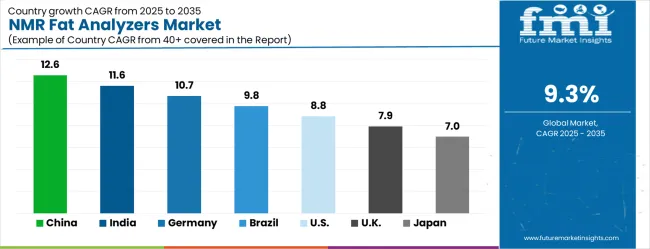
The NMR Fat Analyzers market demonstrates varied regional dynamics with Growth Leaders including China (12.6% CAGR) and India (11.6% CAGR) driving expansion through food processing modernization and quality control infrastructure development. Steady Performers encompass Germany (10.7% CAGR), Brazil (9.8% CAGR), and the USA (8.8% CAGR), benefiting from established food industries and advanced analytical technology adoption. Emerging Markets feature the UK (7.9% CAGR) and Japan (7.0% CAGR), where specialized food processing applications and quality control technology integration support consistent growth patterns.
| Country | CAGR (2025-2035) |
|---|---|
| China | 12.6% |
| India | 11.6% |
| Germany | 10.7% |
| Brazil | 9.8% |
| USA | 8.8% |
| UK | 7.9% |
| Japan | 7.0% |
Regional synthesis reveals Asia-Pacific markets leading growth through food processing modernization and quality control infrastructure development, while European countries maintain strong expansion supported by analytical technology advancement and food safety standardization requirements. North American markets show solid growth driven by food quality control applications and laboratory technology integration trends.
China establishes market leadership through aggressive food processing modernization programs and comprehensive quality control infrastructure development, integrating advanced NMR fat analyzers as standard components in dairy processing operations and nutritional analysis applications. The country's 12.6% CAGR through 2035 reflects government initiatives promoting food safety technology and domestic analytical capabilities that mandate advanced testing systems in food processing facilities and quality control laboratories. Growth concentrates in major food processing centers, including Beijing, Shanghai, and Guangzhou, where quality control development showcases integrated analytical systems that appeal to domestic food manufacturers seeking advanced nutritional analysis capabilities and regulatory compliance applications.
Chinese manufacturers are developing cost-effective NMR analyzer solutions that combine domestic production advantages with advanced features, including rapid testing systems and enhanced measurement accuracy capabilities. Distribution channels through analytical equipment suppliers and laboratory system integrators expand market access while government funding for food safety technology development supports adoption across diverse food processing and quality control segments.
Strategic Market Indicators:
In Mumbai, Delhi, and Bangalore, food processing and dairy manufacturing facilities are implementing advanced NMR fat analyzers as standard equipment for quality control operations and nutritional analysis applications, driven by increasing food safety spending and modernization programs that emphasize accurate testing capabilities. The market is projected to demonstrate an 11.6% CAGR through 2035, supported by government food safety initiatives and infrastructure development programs that promote advanced analytical equipment for food processing and quality control facilities. Indian food companies are adopting NMR analyzer systems that provide rapid fat content measurement capabilities and regulatory compliance features, particularly appealing in dairy processing regions where accuracy represents critical operational requirements.
Market expansion benefits from growing food processing automation capabilities and international technology transfer agreements that enable domestic production of advanced analytical systems for food quality control and nutritional analysis applications. Technology adoption follows patterns established in laboratory automation, where accuracy and reliability drive procurement decisions and operational deployment.
Market Intelligence Brief:
Germany's advanced analytical technology market demonstrates sophisticated NMR fat analyzer deployment with documented operational effectiveness in food quality control and nutritional analysis applications through integration with existing laboratory systems and quality management infrastructure. The country leverages engineering expertise in analytical instrumentation and food technology integration to maintain a 10.7% CAGR through 2035. Manufacturing centers, including Bavaria, Baden-Württemberg, and North Rhine-Westphalia, showcase premium installations where NMR analyzer systems integrate with comprehensive quality control platforms and regulatory compliance systems to optimize testing efficiency and measurement accuracy effectiveness.
German analytical equipment manufacturers prioritize system reliability and European quality standards in NMR analyzer development, creating demand for premium systems with advanced features, including environmental durability and integration with laboratory information management systems. The market benefits from established food processing infrastructure and willingness to invest in advanced analytical technologies that provide long-term operational benefits and compliance with international food safety requirements.
Market Intelligence Brief:
Brazil's market expansion benefits from diverse food processing demand, including dairy manufacturing modernization in São Paulo and Rio de Janeiro, meat processing industry equipment upgrades, and government food safety programs that increasingly incorporate advanced analytical solutions for quality control applications. The country maintains a 9.8% CAGR through 2035, driven by rising food safety investments and increasing awareness of NMR analyzer technology benefits, including rapid testing and enhanced measurement accuracy capabilities.
Market dynamics focus on cost-effective analytical solutions that balance advanced testing features with affordability considerations important to Brazilian food processors. Growing food industrialization creates sustained demand for modern quality control systems in new processing facilities and laboratory equipment modernization projects.
Strategic Market Considerations:
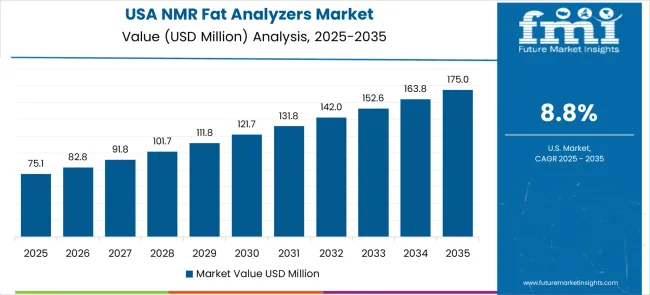
The USA market emphasizes advanced NMR analyzer features, including rapid testing systems and integration with comprehensive laboratory platforms that manage quality control, nutritional analysis, and regulatory compliance applications through unified analytical systems. The country is projected to show an 8.8% CAGR through 2035, driven by food processing modernization under laboratory equipment upgrades and commercial facility demand for reliable analytical systems. American food processing facilities prioritize operational effectiveness with NMR analyzer systems delivering consistent measurement performance through advanced analytical algorithms and quality management integration capabilities.
Technology deployment channels include major analytical equipment suppliers, specialized laboratory system integrators, and commercial procurement programs that support professional installation for complex food processing applications. Laboratory platform integration capabilities with established quality management systems expand market appeal across diverse operational requirements seeking accuracy and reliability benefits.
Performance Metrics:
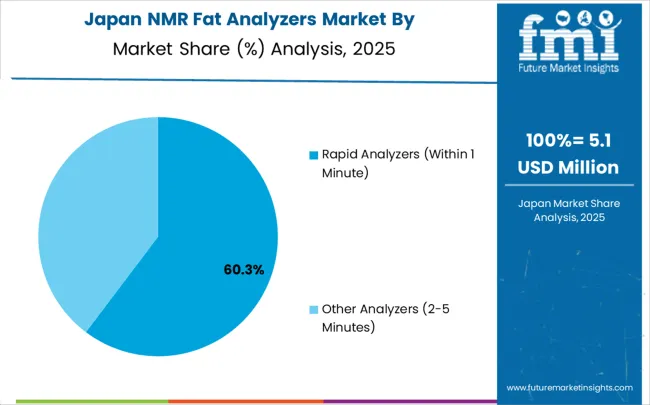
Japan demonstrates steady market development with a 7.0% CAGR through 2035, distinguished by food processing industries' preference for high-quality NMR analyzer systems that integrate seamlessly with existing quality control systems and provide reliable long-term operation in specialized analytical applications. The market prioritizes advanced features, including measurement precision, environmental durability, and integration with comprehensive quality management platforms that reflect Japanese food industry expectations for technological sophistication and operational excellence.
In London, Manchester, and other food processing centers, British food manufacturing facilities and quality control laboratories are implementing advanced NMR fat analyzers to enhance testing capabilities and support analytical operations that align with food safety requirements and nutritional labeling protocols. The UK market demonstrates sustained growth with a 7.9% CAGR through 2035, driven by food safety modernization programs and laboratory equipment upgrades that emphasize advanced analytical systems for food processing and quality control applications. British food facilities are prioritizing NMR analyzer systems that provide rapid fat content measurement capabilities while maintaining compliance with regulatory standards and minimizing testing risks, particularly important in dairy processing and food manufacturing operations.
Market expansion benefits from government food safety development programs that mandate analytical capabilities in laboratory equipment specifications, creating sustained demand across the UK's food processing and quality control sectors where measurement accuracy and testing efficiency represent critical requirements. The regulatory framework supports NMR analyzer adoption through food safety standards and quality requirements that promote advanced analytical systems aligned with European food technology capabilities.
Strategic Market Indicators:
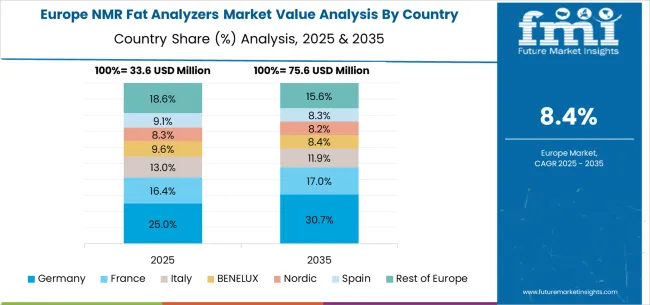
The European NMR Fat Analyzers market is projected to grow from USD 31.8 million in 2025 to USD 77.3 million by 2035, registering a CAGR of 9.3% over the forecast period. Germany is expected to maintain its leadership position with a 33.6% market share in 2025, declining slightly to 33.2% by 2035, supported by its advanced food processing infrastructure and major analytical technology centers, including Bavaria and Baden-Württemberg.
France follows with a 19.2% share in 2025, projected to reach 19.5% by 2035, driven by comprehensive food safety modernization programs and the development of analytical technology initiatives. The United Kingdom is expected to hold a 17.1% share in 2025, with this share projected to remain at 16.8% by 2035, driven by specialized food processing applications and European standardization requirements. Italy commands a 13.4% share, while Spain accounts for 9.3% in 2025. The Rest of Europe region is anticipated to gain momentum, expanding its collective share from 7.4% to 8.2% by 2035, driven by increasing NMR analyzer adoption in Nordic countries and the implementation of quality control modernization programs in emerging Eastern European food processing facilities.
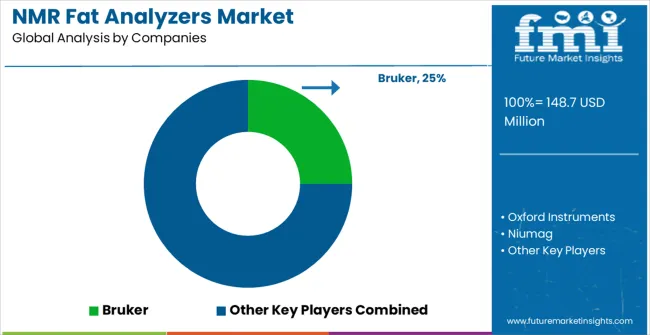
The NMR Fat Analyzers market operates with moderate concentration, featuring approximately 12-15 meaningful participants, where leading companies control roughly 65-70% of the global market share through established analytical technology relationships and comprehensive instrument portfolios. Bruker maintains the leading market share with approximately 25-30% of the global market, followed by Oxford Instruments with 18-22% market share, while Niumag holds 12-15% market share position. Competition emphasizes advanced analytical capabilities, measurement accuracy, and laboratory platform integration rather than price-based rivalry.
Market Leaders encompass Bruker (25-30% market share), Oxford Instruments (18-22% market share), and Niumag (12-15% market share), which maintain competitive advantages through extensive analytical instrumentation expertise, global laboratory equipment networks, and comprehensive system integration capabilities that create customer switching costs and support premium pricing. These companies leverage decades of analytical technology experience and ongoing research investments to develop advanced NMR analyzer systems with rapid testing and environmental durability features.
Technology Challengers include Spinlock, CEM, and Nanbei Instrument, which compete through specialized analytical technology focus and innovative measurement interfaces that appeal to food processing customers seeking advanced precision capabilities and operational flexibility. These companies differentiate through rapid technology development cycles and specialized food industry application focus.
Regional Specialists feature companies focusing on specific geographic markets and specialized applications, including rapid testing systems and integrated quality control solutions. Market dynamics favor participants that combine reliable analytical hardware with advanced measurement software, including automated sample handling and real-time data processing capabilities. Competitive pressure intensifies as traditional analytical instrument companies expand into NMR fat analysis systems. Specialized food technology manufacturers challenge established players by offering innovative testing solutions and cost-effective platforms that target specialized food processing segments.
| Item | Value |
|---|---|
| Quantitative Units | USD 148.7 Million |
| Product Type | Rapid Analyzers (Within 1 Minute), Other Analyzers (2-5 Minutes) |
| Application | Dairy Products, Meat, Oilseeds, Processed Foods, Other |
| Regions Covered | Asia Pacific, Europe, North America, Latin America, Middle East & Africa |
| Countries Covered | China, India, Germany, Brazil, the USA, the UK, Japan, and 25+ additional countries |
| Key Companies Profiled | Bruker, Oxford Instruments, Niumag, Spinlock, CEM, Nanbei Instrument |
| Additional Attributes | Dollar sales by product type and application categories, regional adoption trends across Asia Pacific, Europe, and North America, competitive landscape with analytical instrument companies and technology providers, food industry preferences for rapid testing and measurement accuracy, integration with laboratory information management systems and quality control platforms, innovations in NMR technology and automated analytical capabilities, and development of rapid analyzer solutions with enhanced speed and precision capabilities. |
How big is the NMR Fat Analyzers market in 2025?
The global NMR Fat Analyzers market is valued at USD 148.7 million in 2025.
What will be the size of the NMR Fat Analyzers market in 2035?
The size of the NMR Fat Analyzers market is projected to reach USD 361.7 million by 2035.
How much will the NMR Fat Analyzers market grow between 2025 and 2035?
The NMR Fat Analyzers market is expected to grow at a 9.3% CAGR between 2025 and 2035.
What are the key product type segments in the NMR Fat Analyzers market?
The key product type segments in the NMR Fat Analyzers market are Rapid Analyzers (Within 1 Minute) and Other Analyzers (2-5 Minutes).
Which application segment is expected to contribute a significant share to the NMR Fat Analyzers market in 2025?
In terms of application, the Dairy Products segment is set to command the dominant share in the NMR Fat Analyzers market in 2025.
The global NMR fat analyzers market is estimated to be valued at USD 148.7 million in 2025.
The market size for the NMR fat analyzers market is projected to reach USD 361.7 million by 2035.
The NMR fat analyzers market is expected to grow at a 9.3% CAGR between 2025 and 2035.
The key product types in NMR fat analyzers market are rapid analyzers (within 1 minute) and other analyzers (2-5 minutes).
In terms of application, dairy products segment to command 40.0% share in the NMR fat analyzers market in 2025.






Our Research Products

The "Full Research Suite" delivers actionable market intel, deep dives on markets or technologies, so clients act faster, cut risk, and unlock growth.

The Leaderboard benchmarks and ranks top vendors, classifying them as Established Leaders, Leading Challengers, or Disruptors & Challengers.

Locates where complements amplify value and substitutes erode it, forecasting net impact by horizon

We deliver granular, decision-grade intel: market sizing, 5-year forecasts, pricing, adoption, usage, revenue, and operational KPIs—plus competitor tracking, regulation, and value chains—across 60 countries broadly.

Spot the shifts before they hit your P&L. We track inflection points, adoption curves, pricing moves, and ecosystem plays to show where demand is heading, why it is changing, and what to do next across high-growth markets and disruptive tech

Real-time reads of user behavior. We track shifting priorities, perceptions of today’s and next-gen services, and provider experience, then pace how fast tech moves from trial to adoption, blending buyer, consumer, and channel inputs with social signals (#WhySwitch, #UX).

Partner with our analyst team to build a custom report designed around your business priorities. From analysing market trends to assessing competitors or crafting bespoke datasets, we tailor insights to your needs.
Supplier Intelligence
Discovery & Profiling
Capacity & Footprint
Performance & Risk
Compliance & Governance
Commercial Readiness
Who Supplies Whom
Scorecards & Shortlists
Playbooks & Docs
Category Intelligence
Definition & Scope
Demand & Use Cases
Cost Drivers
Market Structure
Supply Chain Map
Trade & Policy
Operating Norms
Deliverables
Buyer Intelligence
Account Basics
Spend & Scope
Procurement Model
Vendor Requirements
Terms & Policies
Entry Strategy
Pain Points & Triggers
Outputs
Pricing Analysis
Benchmarks
Trends
Should-Cost
Indexation
Landed Cost
Commercial Terms
Deliverables
Brand Analysis
Positioning & Value Prop
Share & Presence
Customer Evidence
Go-to-Market
Digital & Reputation
Compliance & Trust
KPIs & Gaps
Outputs
Full Research Suite comprises of:
Market outlook & trends analysis
Interviews & case studies
Strategic recommendations
Vendor profiles & capabilities analysis
5-year forecasts
8 regions and 60+ country-level data splits
Market segment data splits
12 months of continuous data updates
DELIVERED AS:
PDF EXCEL ONLINE
Fatigue Testing Machine Market Size and Share Forecast Outlook 2025 to 2035
Fats And Oils Market Size and Share Forecast Outlook 2025 to 2035
Fatty Methyl Ester Sulfonate Market Size and Share Forecast Outlook 2025 to 2035
Fatty Acids Market Size and Share Forecast Outlook 2025 to 2035
Fat Replacers, Salt Reducers and Replacers Market Size and Share Forecast Outlook 2025 to 2035
Fatty Acid Supplements Market Size and Share Forecast Outlook 2025 to 2035
Fat Filled Milk Powder Market Analysis - Size, Share, and Forecast Outlook 2025 to 2035
Fat Replacers Market Analysis - Size, Share, and Forecast Outlook 2025 to 2035
Fat Soluble Vitamins Market Analysis - Size, Share, and Forecast Outlook 2025 to 2035
Fatty Amine Market Analysis by Product Type, End Use, and Region Forecast Through 2035
Fatty Liver Treatment Market - Trends & Forecast 2025 to 2035
Fatty Esters Market Growth - Trends & Forecast 2025 to 2035
Fat-Replacing Starch Market
Fat Free Salad Dressings Market
Sulfate-Free Shampoos Market Analysis - Size, Share, and Forecast Outlook 2025 to 2035
No-Fat Cake Market Trends - Innovations & Consumer Demand 2025 to 2035
No-Fat Peanut Butter Market Trends - Consumer Demand & Growth 2025 to 2035
Non-fat Dry Milk Market Size and Share Forecast Outlook 2025 to 2035
Low Fat Drinks Market Size and Share Forecast Outlook 2025 to 2035
Low Fat Content Kefir Market Size and Share Forecast Outlook 2025 to 2035

Thank you!
You will receive an email from our Business Development Manager. Please be sure to check your SPAM/JUNK folder too.
Chat With
MaRIA